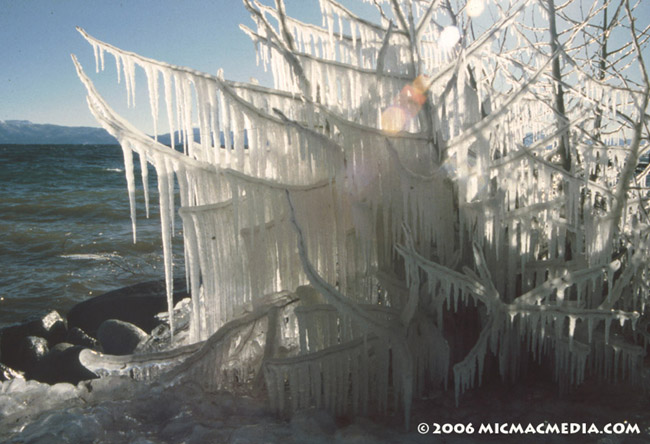|
Tahoe Nugget #38:
East Wind Blues
An east wind in the continental U.S. is often called an ill wind. Along the Atlantic Coast, a gusty wind out of the east usually portends serious precipitation (in winter they call it a Nor'Easter), which can
generate the kind of social chaos that entertained me as a child. And still does today I must admit.
A relatively mellow east wind (temperature-wise) has prevailed here in Tahoe the past two days, but
tonight wind gusts are flirting with 80 - 90 mph on the remote mountain peaks and are unusually strong and steady here in Carnelian Bay. Trees are dancing and the chimes are singing. Strong low pressure over
Southern California is sucking in the dry, cold, continental air mass invading the Great Basin. At least the present flow failed to tap any arctic air so temperatures remain relatively warm (upper 30s for highs
today).
An east wind is caused by a dense pool of cold air settling in over the Great Basin, which then pours like fluid west over the Sierra range. As it descends down the Sierra west slope, it compresses,
warms, loses moisture, and often wreaks havoc in Southern California in the form of a gusty, damaging wind. Residents down south in the coastal valleys fear the Santa Ana wind, a down slope wind event that is
extremely dry and a serious wildfire threat in parts of California. Today, parts of southern California are experiencing fires and power outages due to the Santa Ana wind.
When a sub-freezing east wind
drives waves onto the shores of Tahoe, cool things happen. This ice-coated bush survives on Tahoe City Commons Beach. Remember, Lake Tahoe has never been known to freeze, no matter how cold the wind. Partly because
of its great depth and volume, and partly due to its proximity to the on-shore flow of the Pacific Ocean, only 200 miles away.

|



